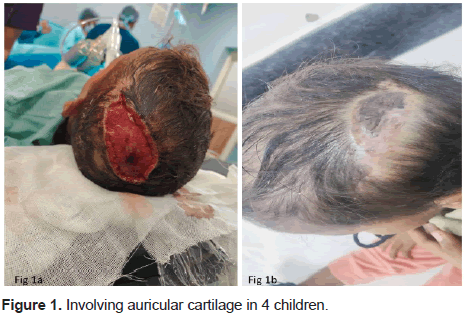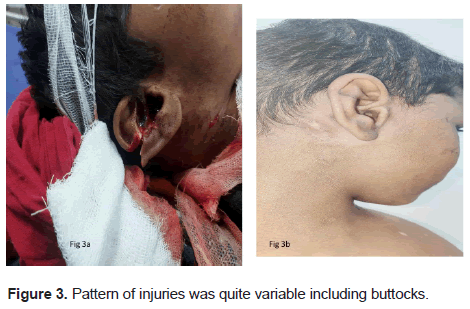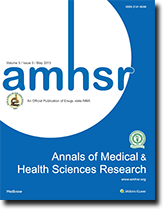Dog bite or dog eaten!! Our experience in the surgical management of dog bite injuries
Received: 31-Jan-2025, Manuscript No. amhsr-24-160574; Editor assigned: 03-Feb-2025, Pre QC No. amhsr-24-160574 (PQ); Reviewed: 17-Feb-2025 QC No. amhsr-24-160574 (Q); Revised: 24-Feb-2025, Manuscript No. amhsr-24-160574 (R); Published: 03-Mar-2025
Citation: Behera S, et al. Dog Bite or Dog Eaten!! Our Experience in the Surgical Management of Dog Bite Injuries. Ann Med Health Sci Res. 2025; 1086-1089.
This open-access article is distributed under the terms of the Creative Commons Attribution Non-Commercial License (CC BY-NC) (http://creativecommons.org/licenses/by-nc/4.0/), which permits reuse, distribution and reproduction of the article, provided that the original work is properly cited and the reuse is restricted to noncommercial purposes. For commercial reuse, contact reprints@pulsus.com
Abstract
Background: Dog bite injuries in children are usually grievous and can cause major disability if not addressed on time. In this study, we have summarized our experience on high-grade dog bite injuries in children who required prompt surgical repair after resuscitation. Materials and methods: We retrospectively analyzed the clinical profile of 11 patients of dog bite who were surgically managed in our department during the last 8 months (March 2024-October 2024), including their 6-month follow-up. The characteristics of the victims, the nature of circumstances, the types of dogs encountered and the type and severity of injuries inflicted were studied. Results: The study is ongoing on a population basis in our institution, and over a period of 1 year, dog bite injury necessitated emergency visit in 164 patients where 11 children suffered from severe bites of stray dogs managed with immediate surgical intervention. These were category III exposure as per the national guidelines for Rabies prophylaxis 2019. Hence wound management and administration of Rabies vaccine and immunoglobulins were done as per the protocol. The patients were in the toddler age group (1-3 years) where the youngest child was 18 months old. Majority were males (8 out of 11 children). All the 11 children inflicted major injuries to head and neck region with midface commonly affected with modified Lackmann” s class III A (complete avulsion) and class III B (involving auricular cartilage in 4 children) injuries. Major skin and subcutaneous tissue loss were seen in 3 children who required rotational flaps and split skin grafting for coverage. Underlying bony injuries (shaft of humerus and depressed skull fractures) were found in one child managed by the Orthopedic and neurosurgery teams. The pattern of injuries was quite variable including buttocks (6 children), trunk and limbs (5 out of 11 children). All the children underwent thorough wound lavage, antibiotics prophylaxis and immediate surgical repair. Wounds were healthy leading to satisfactory cosmetic scars on 3 months follow up. Conclusion: Our data shows the typical high-grade dog related injuries in children are caused by unevoked bites of stray dogs during spring and summer seasons. The victims are mostly younger boys who sustain injuries to head and neck region including deep facial avulsions. Timely referral to higher centers for proper wound management and surgical repair can avoid unsightly scars and wound infections.
Keywords
Dog bite injuries; Children; Head and neck injuries; Public health concern; Integrated approach; Community education; Modified Lackmanns classification
Introduction
In recent years, the incidence of dog bite injuries has emerged as a significant public health concern, particularly among pediatric population in North India where almost two fifths of the patients did not wash their wounds with simple soap and water [1]. Uncontrolled interactions between children and dogs, coupled with a lack of awareness regarding safe coexistence, have contributed to a rise in the number of dog bite injuries. These incidents can pose long-term psychological consequences. Pre-clinical practices frequently deviate from recommendations. Such non-compliance is driven by factors that affect the health-seeking behaviour of people as well as their knowledge, attitudes, and practices toward dog bite outcomes like rabies. This is why dog bite management has been linked to geographical, social, economic, cultural, and organizational, as well as dog and wound factors [2].
Despite clear mandates by the World Health Organization (WHO) for dog bite victims before presenting to a healthcare facility (preclinical management) as well as healthcare facility (clinical guidelines), clinical practices are poor on the ground [3].
In contrast to the studies done in Western population where most of the bites were inflicted by pets who are vaccinated and under routine veterinary care, in developing countries like ours dog bites are inflicted commonly by stray dogs.
Children in particular, is a vulnerable community because of their small stature and less defence. It has been observed that the pediatric population under threat is mostly the unattended children in unprivileged society where both the parents are daily wage workers with limited backup care for these children. They are mostly found to be engaged in activities provoking aggression and dog attack [4]. The delayed or lack of response from children makes them an easy victim when a dog interaction is expected. The wounds inflicted are deeper and of severe grade sometimes involving structures like underlying bony and soft tissue which require immediate attention and management in the forms of primary tagging sutures or bony fixation. Thus a multimodal approach is necessary in such cases.
Material and Methods
This was a single center retrospective observational study conducted in All India Institute of Medical Sciences, Bathinda Punjab from January 2024–December 2024. Out of 164 patients of dog bite injury in triage, 11 children presented to the department of pediatric surgery with injuries requiring surgical intervention. Clinical presentation along with detailed history were noted for all the children received in triage. Clinical records analyzed of patient’s age, gender, demographic profile, circumstances of exposure (dog ownership, relationship between victim and dog, any prior events to provoke the animal), nature and characteristics of injuries sustained (facial wounds were classified as per the Modified Lackmann’s classification). Wound management like thorough lavage, administration of tetanus toxoid, rabies vaccine and immunoglobulins were administered as per the post exposure guidelines of National Rabies Control Program.
After wound irrigation, we infiltrated the equine rabies immunoglobulin 40IU per kg body weight in and around the affected areas called as Antirabies Serum (ARS). Purified chick embryo Antirabies Vaccine (ARV) was given for active immunization according to the updated Thai red cross schedule. Reconstituted vaccine (0.5 ml) per site (on two sites per visit) was injected intradermally on days 0, 3, 7 and 28.
After initial resuscitation, the patients underwent surgical repair which included debridement, primary repair, split skin grafts and rotational grafts etc. Long bone injuries were fixed by orthopedic team in the same setting.
All the children were followed up for 6 months and postoperative complications were managed accordingly.
Results
The study is ongoing on a population basis in our institution, and over a period of 1 year, dog bite injury necessitated emergency visit in 164 pediatric patients where 11 children suffered from severe bites of stray dogs managed with immediate surgical intervention.
The patients were in the toddler age group (1-3 years) where the youngest child was 18 months old. Majority were males (8 out of 11 children). All the children belonged to Malwa region and adjoining regions of Bathinda, Punjab.
The bites were confronted mostly during spring season from unproved attacks by group of stray dogs (more than 3 dogs) which were unvaccinated. These were category III exposure as per the national guidelines for Rabies prophylaxis 2019. Hence wound management and administration of Rabies vaccine and immunoglobulins were done as per the protocol.
There was a noticeable delay in the referral of 8 patients (more than 24 hours) to a tertiary center like ours. Six of these children did not have a proper wound wash and five children had history of local application of homemade mixtures like chillies, salt, turmeric powder, lime, snuff powder, a paste of leaves, acid, and ash provided by traditional healers and magicians.
All the 11 children inflicted major injuries to head and neck region with midface commonly affected with modified Lackmann” s class III A (complete avulsion) in 5 and class III B (involving auricular cartilage in 4 children) (Figure 1).
Major skin and subcutaneous tissue loss were seen in 3 children who required rotational flaps in two and split skin grafting in one child for coverage.
Underlying bony injuries (shaft of humerus and depressed skull fractures) were found in one child managed by the Orthopedic and neurosurgery teams) (Figure 2). The pattern of injuries was quite variable including buttocks (6 children), trunk and limbs (5 out of 11 children)) (Figure 3, 4). All the children underwent thorough wound lavage, antibiotics prophylaxis and immediate surgical repair. One of the patients with Lackmanns class III wound developed hypertrophic scar, which were managed conservatively with intralesional steroids. Overall, wounds were healthy in all children leading to satisfactory cosmetic scars on 3 months follow up.
Discussion
Dog bite is a significant public health issue and the incidences are increasing daily [5]. The annual estimated number of dog bites in India is 17.4 million, leading to estimated 18,000–20,000 cases of human rabies per year [6]. There are little data on the incidence of animal bites from India. The World Health Organization (WHO) supports targets for elimination of human rabies transmitted by dogs in South-East Asia by 2020. In this region, a 5-year plan (2012–2016) aims to halve the currently estimated number of human rabies deaths in endemic countries [7]. The available studies on dog bites and rabies in India are mostly hospital-based, and limited to disease management [8, 9].
Medical interventions
Several studies highlight the immediate medical consequences of dog bite injuries, emphasizing the importance of prompt and appropriate medical intervention [10–12]. Findings underscore the prevalence of bacterial infections, particularly from canine oral flora, which necessitates early wound management and antibiotic therapy. In our series, there was a noticeable delay in the referral of 8 patients (more than 24 hours) to a tertiary center like ours. Six of these children did not have a proper wound wash and five children had history of local application of homemade mixtures.
Furthermore, research indicates that paediatric victims often experience more severe outcomes, including facial injuries, psychological trauma, and a higher risk of infections [13–15]. In our series, all the 11 children inflicted major injuries to head and neck region with midface commonly affected with modified Lackmann’s class III A (complete avulsion) in 5 and class III B (involving auricular cartilage in 4 children). Major skin and subcutaneous tissue loss were seen in 3 children who required rotational flaps in two and split skin grafting in one child for coverage.
Underlying bony injuries (shaft of humerus and depressed skull fractures) were found in one child managed by the Orthopedic and neurosurgery teams. The pattern of injuries was quite variable including buttocks (6 children), trunk and limbs (5 out of 11 children).
These insights emphasize the need for tailored medical protocols within an integrated approach, ensuring efficient triage, wound care, and psychological support for affected children. Children are the largest percentage of people bitten by dogs, with the majority in their mid-to-late childhood. The risk of injury to the head and neck is greater in children than in adults, adding to increased severity, necessity for medical treatment and death rates [16–17].
The wounds inflicted are deeper and of severe grade sometimes involving structures like underlying bony and soft tissue which require immediate attention and management in the forms of primary tagging sutures or bony fixation. Thus a multimodal approach is necessary in such cases.
Sociocultural dynamics
Cultural factors play a significant role in shaping the interactions between children and dogs in North India. Studies have shown seasonal variation in the pattern of dog bite injuries, which may vary in different communities and population. These variation may depend upon the dog breeding season or the time corresponding to increased human outdoor recreational activities [18]. As per our study, most of the bites were confronted mostly during spring season from unproved attacks by group of stray dogs (more than 3 dogs) which were unvaccinated.
Conclusion
This literature review underscores the urgency of addressing dog bite injuries in paediatric populations in North India through a holistic and integrated approach. Timely referral to higher centers for proper wound management and surgical repair can avoid unsightly scars, wound infections and psychosocial morbidity in children.
References
- Sharma S, Agarwal A, Khan AM, Ingle GK. Prevalence of Dog Bites in Rural and Urban Slums of Delhi: A Community-based Study. Ann Med Health Sci Res. 2016;6(2):115-119.
[Crossref] [Google Scholar] [PubMed]
- Edens MA, Michel JA, Jones N. Mammalian Bites In The Emergency Department: Recommendations For Wound Closure, Antibiotics, and Postexposure Prophylaxis. Emerg Med Pract. 2016;18:1â?20.
[Google Scholar] [PubMed]
- Gongal G, Wright AE. Human rabies in the WHO Southeast Asia region: Forward steps for elimination. Adv Prev Med 2011. 2011 383870.
[Crossref] [Google Scholar] [PubMed]
- Aziz H, Rhee P, Pandit V, Tang A, Gries L, et al. The current concepts in management of animal (dog, cat, snake, scorpion) and human bite wounds. J Trauma Acute Care Surg. 2015;78(3):641-8.
[Crossref] [Google Scholar] [PubMed]
- Shantavasinkul P, Wilde H. Postexposure prophylaxis for rabies in resource-limited/poor countries. Advances in virus research. 2011;79:291-307.
[Crossref] [Google Scholar] [PubMed]
- Duncan-Sutherland N, Lissaman AC, Shepherd M, et al. Systematic review of dog bite prevention strategies. Inj Prev. 2022;28:288–297.
[Crossref] [Google Scholar] [PubMed]
- Kisaka S, Makumbi FE, Majalija S, Bangirana A, Thumbi SM. Epidemiology and preclinical management of dog bites among humans in Wakiso and Kampala districts, Uganda: Implications for prevention of dog bites and rabies. PLoS ONE. 2020; 15(9): e0239090.
[Crossref] [Google Scholar] [PubMed]
- World Health Organization. Current WHO guide for rabies pre and post-exposure treatment in humans. Geneva. 2002.
- Edens MA, Michel JA, Jones N. Mammalian Bites in The Emergency Department: Recommendations For Wound Closure, Antibiotics, and Postexposure Prophylaxis. Emerg Med Pract. 2016;18:1â?20.
[Google Scholar] [PubMed]
- Gongal G, Wright AE. Human rabies in the WHO Southeast Asia region: Forward steps for elimination. Adv Prev Med; 2011: 383870.
[Crossref] [Google Scholar] [PubMed]
- WHO Fact Sheet. World Health Organization. 2013.
- Gogtay NJ, Nagpal A, Mallad A, Patel K, Stimpson SJ, et al. Demographics of animal bite victims & management practices in a tertiary care institute in Mumbai, Maharashtra, India. Indian J Med Res. 2014;139:459–62.
[Google Scholar] [PubMed]
- Ghosh A, Pal R. Profile of dog bite cases in an urban area of Kolkata, India. Natl J Community Med. 2014;5:321–4.
- Umrigar P, Parmar GB, Patel PB, Bansal RK. Epidemiology of animal bite cases attending municipal tertiary care centres in Surat city: A cross-sectional study. Natl J Community Med. 2013;4:153–7.
- SA Shirwa, Sharaf SA. Dog bite injuries to the face: A narrative review of the literature. World J Otorhinolaryngol Head Neck Surg. 2022; 8(3): 239–244.
[Crossref] [Google Scholar] [PubMed]
- Gogtay NJ, Nagpal A, Mallad A, Patel K, Stimpson SJ, et al. Demographics of animal bite victims & management practices in a tertiary care institute in Mumbai, Maharashtra, India. Indian J Med Res. 2014;139:459–62.
[Google Scholar] [PubMed]
- Essig GF, Sheehan CC, Niermeyer WL, Lopez JJ, Elmaraghy CA. Treatment of Facial Dog Bite Injuries in the Emergency Department Compared to the Operating Room. OTO Open. 2019; 3(3).
[Crossref] [Google Scholar] [PubMed]
- NHS Digital. Provisional Monthly Topic of interest: admissions caused by dogs and other mammals. 2015.








 The Annals of Medical and Health Sciences Research is a monthly multidisciplinary medical journal.
The Annals of Medical and Health Sciences Research is a monthly multidisciplinary medical journal.